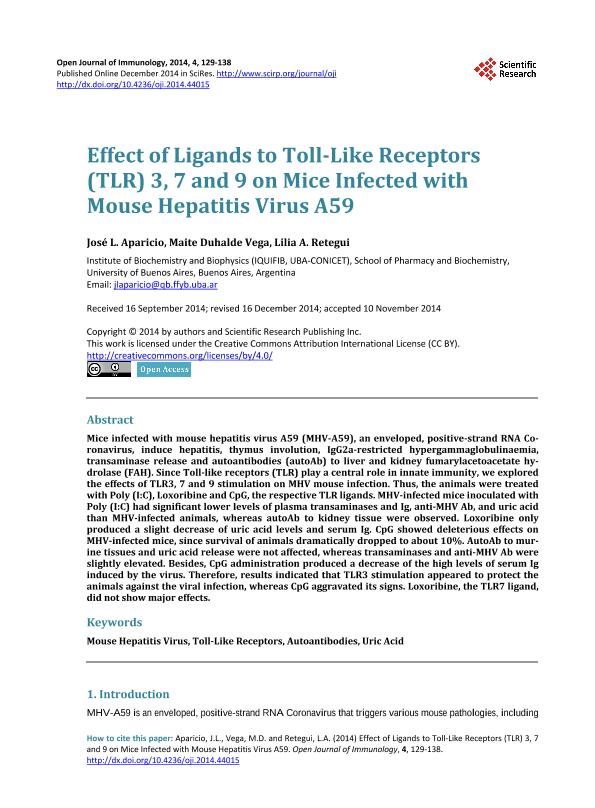Artículo
Effect of ligands to toll-like receptors (TLR) 3, 7 and 9 on mice infected with mouse hepatitis virus A59
Fecha de publicación:
12/2014
Editorial:
Scientific Research Publishing
Revista:
Open Journal of Immunology
ISSN:
2162-450X
Idioma:
Inglés
Tipo de recurso:
Artículo publicado
Clasificación temática:
Resumen
Mice infected with mouse hepatitis virus A59 (MHV-A59), an enveloped, positive-strand RNA Co-ronavirus, induce hepatitis, thymus involution, IgG2a-restricted hypergammaglobulinaemia, transaminase release and autoantibodies (autoAb) to liver and kidney fumarylacetoacetate hy-drolase (FAH). Since Toll-like receptors (TLR) play a central role in innate immunity, we explored the effects of TLR3, 7 and 9 stimulation on MHV mouse infection. Thus, the animals were treated with Poly (I:C), Loxoribine and CpG, the respective TLR ligands. MHV-infected mice inoculated with Poly (I:C) had significant lower levels of plasma transaminases and Ig, anti-MHV Ab, and uric acid than MHV-infected animals, whereas autoAb to kidney tissue were observed. Loxoribine only produced a slight decrease of uric acid levels and serum Ig. CpG showed deleterious effects on MHV-infected mice, since survival of animals dramatically dropped to about 10%. AutoAb to murine tissues and uric acid release were not affected, whereas transaminases and anti-MHV Ab were slightly elevated. Besides, CpG administration produced a decrease of the high levels of serum Ig induced by the virus. Therefore, results indicated that TLR3 stimulation appeared to protect the animals against the viral infection, whereas CpG aggravated its signs. Loxoribine, the TLR7 ligand, did not show major effects.
Palabras clave:
Mouse Hepatitis Virus
,
Toll-Like Receptors
,
Autoantibodies
,
Uric Acid
Archivos asociados
Licencia
Identificadores
Colecciones
Articulos(IQUIFIB)
Articulos de INST.DE QUIMICA Y FISICO-QUIMICA BIOLOGICAS "PROF. ALEJANDRO C. PALADINI"
Articulos de INST.DE QUIMICA Y FISICO-QUIMICA BIOLOGICAS "PROF. ALEJANDRO C. PALADINI"
Citación
Aparicio, Jose Luis; Duhalde Vega, Maite; Retegui, Lilia Alicia; Effect of ligands to toll-like receptors (TLR) 3, 7 and 9 on mice infected with mouse hepatitis virus A59; Scientific Research Publishing; Open Journal of Immunology; 4; 4; 12-2014; 129-138
Compartir
Altmétricas




